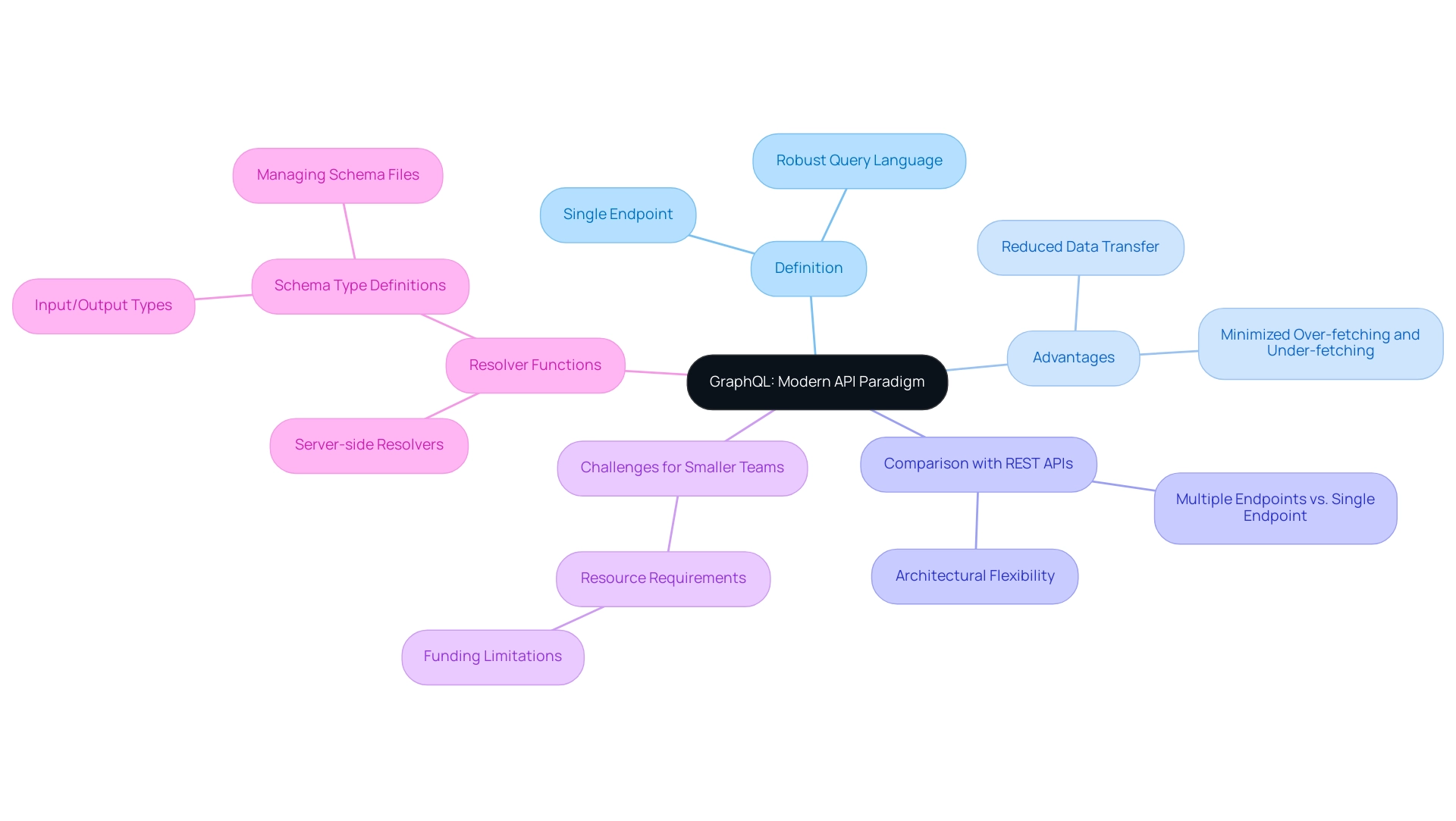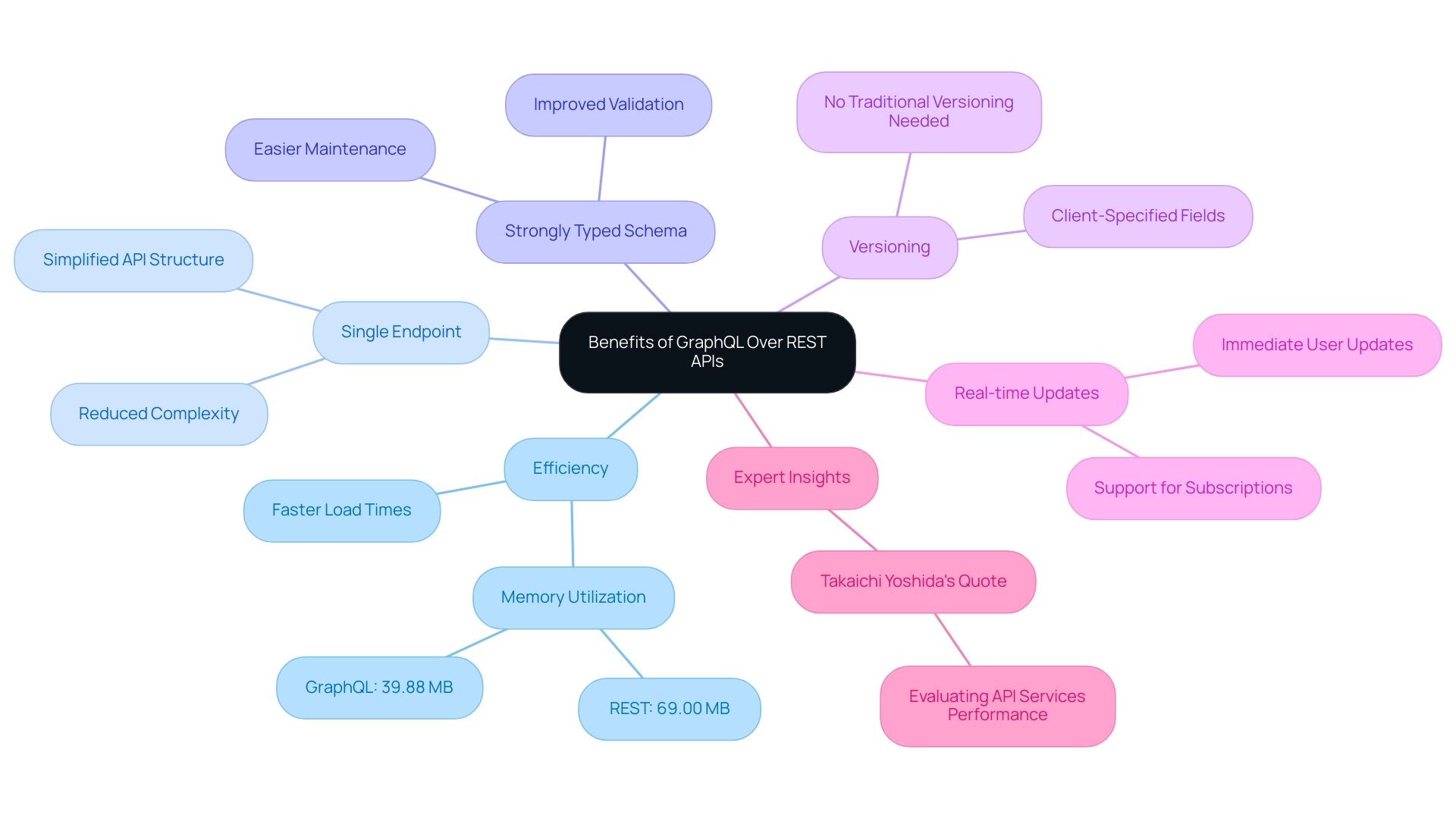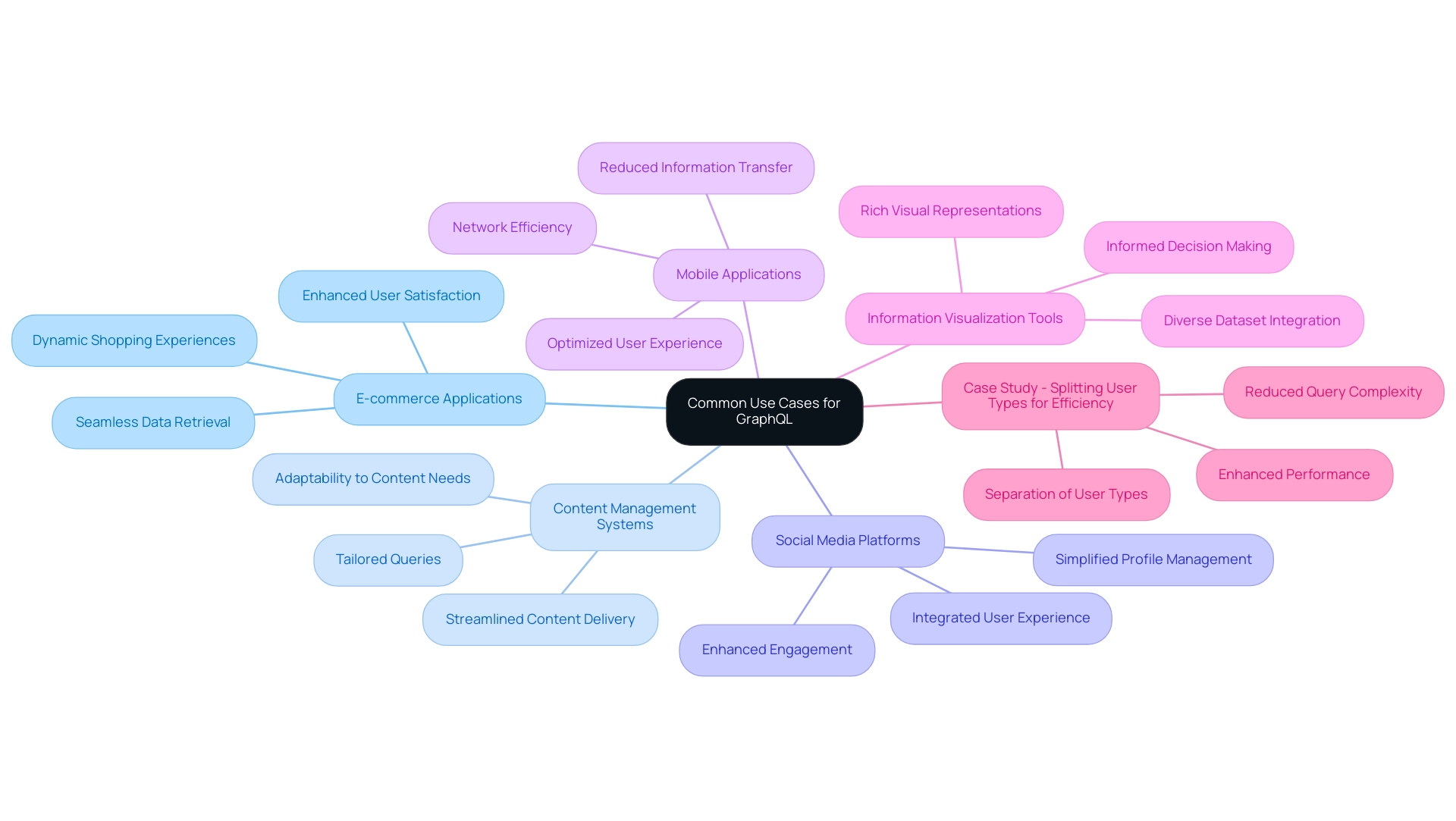Introduction
In the evolving landscape of software development, the demand for efficient and flexible data handling has never been greater. GraphQL emerges as a revolutionary solution, offering a modern approach to API design that empowers developers to fetch exactly what they need with remarkable efficiency.
By consolidating multiple requests into a single endpoint, GraphQL not only streamlines the data retrieval process but also enhances performance, making it an ideal choice for today’s dynamic applications.
This article delves into the transformative benefits of GraphQL, explores real-world examples from industry giants, and provides actionable insights for developers looking to harness its power in their projects.
Whether enhancing user engagement in mobile apps or optimizing e-commerce platforms, understanding GraphQL's capabilities is essential for those aiming to stay ahead in the competitive tech landscape.
Understanding GraphQL: A Modern API Paradigm
A robust query language for APIs, combined with a runtime that runs those queries against current information. Created by Facebook in 2012, this query language has surged in popularity, primarily due to its ability to allow clients to request exactly the information they require. This targeted approach results in significantly reduced data transfer over the network.
In fact, discussions on the API integration dominated the conversation until December 2017, highlighting its relevance in the API landscape. In stark contrast to traditional REST APIs, which require multiple endpoints for different resources, this technology operates through a singular endpoint capable of managing diverse queries and mutations. This architectural flexibility streamlines development processes while enhancing performance by effectively minimizing issues related to over-fetching and under-fetching information.
As Geoff Schmidt, CEO and co-founder of Apollo GraphQL, noted, 'Such endeavors require substantial resources and are beyond the scope of small or medium-sized teams funding to complete,' emphasizing the challenges smaller teams face in implementing this framework. Moreover, the discussion around server-side resolver functions, as illustrated in case studies on resolvers, showcases how developers engage in building resolvers to fetch and manipulate data in these applications. As a result, this technology represents a modern API paradigm that developers are increasingly adopting to design more efficient applications.

Real-World GraphQL API Examples for Developers
- GitHub API: GitHub's API using a graph-based query language stands out as a premier example of this technology in action. It empowers developers to query a wide range of data—repositories, issues, pull requests—through a single, streamlined endpoint. This capability illustrates how this query language, through graphql api examples, simplifies complex interactions, enabling developers to obtain only the essential information without the burden of numerous requests.
- Shopify's GraphQL API examples demonstrate how to transform e-commerce information interaction, enabling developers to efficiently create, update, and query products, orders, and customer details. Its flexible query system significantly decreases transfer volumes, enhancing performance even during peak traffic periods. Expert developers have observed that this API not only enhances speed but also boosts satisfaction.
- Twitter API: Twitter has adopted a query language to enhance its API, enabling effective retrievals for tweets, profiles, and trends. This implementation serves as a clear example of GraphQL API examples that enhance user experience by delivering targeted data retrieval and minimizing unnecessary data load.
- SpaceX API: The SpaceX API provides a comprehensive dataset regarding launches, rockets, and missions, all accessible through a query language. This showcases how developers can effortlessly navigate extensive datasets, making it an ideal resource for applications focused on space exploration and technology.
- Apollo Client: The Apollo suite offers essential tools for developing applications using the query language. Its client library simplifies information retrieval and state management, demonstrating how developers can greatly improve application performance and maintainability through efficient integration.
- Netflix API: Netflix utilizes a query language for efficient content retrieval, enabling personalized recommendations based on individual viewing habits. This method emphasizes how the query language can involve users through customized information delivery, enhancing overall user interaction.
- WordPress GraphQL: The WPGraphQL plugin enables WordPress sites to expose their data through a query language. This integration illustrates how developers can modernize content management systems by using GraphQL API examples, yielding a more flexible and efficient API experience that boosts site performance.
- Contentful API: Contentful, a headless CMS, employs a query language to enable simple querying of content models. This application highlights the significance of this query language in enhancing content delivery for contemporary web applications, ultimately improving efficiency and client satisfaction.
- Discord API: The Discord API utilizes a query language to efficiently manage servers, channels, and messages. This demonstrates the advantages of a query language in real-time applications, where efficient information retrieval is essential for sustaining user engagement and functionality.
- CoinGecko API: CoinGecko's API provides cryptocurrency market data, enabling developers to access price information, market trends, and historical data effectively. This example highlights the adaptability of the technology to dynamic datasets, ensuring applications remain current with minimal overhead.
Overall, the strong typing and schema validation capabilities of this technology are instrumental in ensuring correct entry points to services, further enhancing its appeal across varied industries, including Software Development (762 customers), Web Development (608 customers), and Machine Learning (580 customers). As noted by Sebastian Rabiej, "And even if you could, you should not, because it gives you control during the development process and creates a contract between the API provider and its clients." Additionally, the integration of Postman Vault with external vaults like AWS Key Management and Azure Key Vault emphasizes the framework's influence on enhancing security processes and removing the need for manual secret management.
Benefits of Using GraphQL Over REST APIs
- Efficiency: This technology enables clients to request exactly the information they require, greatly reducing the amount of content sent over the network. This targeted approach not only leads to quicker load times but also enhances overall performance, particularly in mobile applications where bandwidth is limited. In fact, recent studies indicate that this technology achieves a memory utilization of just 39.88 MB, compared to 69.00 MB for REST, underscoring its efficiency in information transfer.
- Single Endpoint: One of the standout features of this technology is its utilization of a single endpoint for all queries and mutations, in contrast to REST APIs that necessitate multiple endpoints for different resources. This streamlined architecture simplifies the API structure, reducing the complexity associated with managing various routes and enhancing overall operational efficiency.
- Strongly Typed Schema: The strength of this technology is further improved by its strongly typed schema that clearly outlines the types of information available for queries. This structure facilitates improved validation and error handling, resulting in APIs that are not only more reliable but also easier to maintain over time.
- Versioning: This technology eliminates the need for traditional versioning by allowing clients to specify the exact fields required in their queries. This flexible design enables developers to innovate and evolve their APIs without disrupting existing clients, ultimately fostering a smoother and more efficient development process.
- Real-time Updates: The ability of this technology to support subscriptions for real-time updates is a game-changer for applications that depend on live data. This feature proves invaluable for platforms like chat applications or stock market trackers, ensuring that users receive immediate updates as changes occur, thereby enhancing user engagement and satisfaction.
- Expert Insights: Takaichi Yoshida states, "Evaluating API Services Performance in a Massive and Intensive Accessible Information System," highlighting the importance of understanding the performance metrics of each API type in various contexts.
- Case Study Reference: A recent case study on the "Performance Evaluation of REST and an alternative Web Service" revealed that while REST outperformed the alternative in speed (51% faster response time and 37% higher throughput), the alternative excelled in resource utilization (37% better CPU load and 40% better memory utilization). This highlights the importance of assessing system requirements and application needs when deciding between REST and another approach.

Common Use Cases for GraphQL
- E-commerce Applications: The graphql api examples illustrate how this query language is a game changer for e-commerce platforms, enabling seamless retrieval of product listings, reviews, and customer information. This API structure empowers developers to craft dynamic, responsive shopping experiences that cater to customer needs. With this query language, e-commerce sites can achieve greater efficiency in data fetching, enhancing user satisfaction and driving conversions. Notably, this query language has supported three years of released Facebook applications on the same version of the API, showcasing its stability and reliability in high-demand environments.
- Content Management Systems: In the realm of content-heavy applications like blogs and news websites, this technology offers unparalleled flexibility. It allows for tailored queries of articles, authors, and categories, streamlining the process of building customizable content delivery systems. Developers can easily adjust to evolving content needs, ensuring that individuals receive pertinent information swiftly and effectively.
- Social Media Platforms: This query language significantly enhances social media applications by simplifying the management of profiles, posts, and interactions. Its ability to retrieve relevant information in a single request enhances engagement, offering a more integrated experience that keeps individuals connected and active on the platform.
- Mobile Applications: With mobile apps often struggling with network efficiency, this technology stands out by reducing information transfer. This optimization guarantees that individuals obtain only the necessary information they require, minimizing overhead and enhancing overall performance. As applications increasingly emphasize user experience, this technology proves to be an ideal solution for mobile development.
- Information Visualization Tools: Applications requiring complex visual representations greatly benefit from GraphQL's flexibility. It enables developers to effortlessly pull in diverse datasets from multiple sources, facilitating rich visual representations of data. This capability not only enhances the functionality of visualization tools but also empowers users to make informed decisions based on comprehensive insights.
- Case Study - Splitting User Types for Efficiency: A practical example of the technology's effectiveness can be seen in the case study titled 'Splitting User Types for Efficiency.' This approach proposes splitting the User type into different concepts based on context, such as separating mortgage and credit card information. By effectively splitting types, the goal is to enhance performance and reduce the complexity of queries, although challenges with type connections may still exist.
- Quote: As developer Mieszko Sabo aptly puts it, 'Good Luck.' This sentiment reflects the challenges and opportunities developers encounter when implementing the technology, highlighting the significance of well-structured queries and effective information management.

Tips for Implementing GraphQL in Your Projects
- Start with a Clear Schema: Establishing a clear and concise schema is fundamental for any successful implementation of the query language. A well-structured schema not only defines the data types and their relationships but also plays a pivotal role in enhancing data efficiency, which is crucial as applications adjust their queries based on screen size. The significance of naming all operations in the query language is emphasized in the case study titled 'Operation Naming in GraphQL,' highlighting that named operations clarify their purpose, avoid errors, and enhance debugging.
Use Fragments: Implement GraphQL fragments to streamline your queries and eliminate redundancy. Fragments enable the creation of reusable query components, significantly improving code maintainability and readability. This practice is particularly beneficial in large applications where consistent structure is necessary.
- Optimize Resolvers: Focus on optimizing your resolvers to enhance performance. Avoiding N+1 query issues is crucial; employ batching techniques and loaders to reduce database calls. This approach not only boosts efficiency but also ensures that your API can handle increased data requests without compromising speed.
- Implement Caching: Adopting effective caching strategies can drastically improve performance and reduce unnecessary network requests. Since hardcoded argument values in queries are treated as distinct operations by the server's cache, leveraging caching smartly can enhance the user experience, especially in data-intensive applications. This statistic emphasizes the necessity for a careful strategy to caching in your implementation.
Monitor Performance: Consistently analyze your API's performance through comprehensive metrics and logging. This practice allows for the identification of bottlenecks and areas needing improvement. Regular performance monitoring ensures that your API remains efficient, scalable, and capable of meeting user demands as traffic increases. As the web technology landscape evolves, with AWS ending support for Internet Explorer on 07/31/2022, it’s crucial to stay updated on best practices and adapt your GraphQL implementations accordingly.
Conclusion
GraphQL stands at the forefront of modern API design, proving to be a game-changer for developers seeking efficiency and flexibility in data handling. Its ability to allow clients to request only the data they need, combined with the streamlined architecture of a single endpoint, fundamentally enhances the performance of applications. The insights drawn from real-world examples, such as GitHub and Shopify, illustrate how GraphQL not only simplifies complex data interactions but also optimizes user satisfaction through tailored data retrieval.
The benefits of adopting GraphQL over traditional REST APIs are undeniable. From minimizing data transfer to eliminating the need for versioning, GraphQL empowers developers to create more responsive applications that can adapt to user needs without compromising on performance. Moreover, its real-time update capabilities and strongly typed schema ensure that applications remain robust and reliable, further solidifying GraphQL's position as an essential tool in the developer's toolkit.
As the demand for efficient and dynamic data handling continues to rise, embracing GraphQL can lead to significant improvements in application performance and user engagement. By implementing best practices such as:
- Clear schema design
- Query optimization
- Effective caching strategies
developers can harness the full potential of GraphQL. In an ever-evolving tech landscape, understanding and leveraging the capabilities of GraphQL will undoubtedly provide a competitive edge and pave the way for innovative solutions that meet the challenges of tomorrow.
Frequently Asked Questions
What is GraphQL and who created it?
GraphQL is a robust query language for APIs, created by Facebook in 2012. It allows clients to request exactly the information they need, resulting in reduced data transfer over the network.
How does GraphQL differ from traditional REST APIs?
Unlike traditional REST APIs that require multiple endpoints for different resources, GraphQL operates through a single endpoint that can manage diverse queries and mutations, streamlining development and minimizing over-fetching and under-fetching issues.
What challenges do smaller teams face when implementing GraphQL?
Implementing GraphQL can require substantial resources, which may be beyond the scope of small or medium-sized teams, as noted by Geoff Schmidt, CEO and co-founder of Apollo GraphQL.
What are server-side resolver functions in the context of GraphQL?
Server-side resolver functions are used by developers to fetch and manipulate data within GraphQL applications, showcasing the technology's flexibility and capability.
Can you provide examples of companies using GraphQL APIs?
Yes, several companies utilize GraphQL APIs, including: 1. GitHub API - for querying repositories and issues. 2. Shopify's GraphQL API - for managing e-commerce data. 3. Twitter API - for effective tweet and profile retrieval. 4. SpaceX API - for accessing launch and mission data. 5. Apollo Client - for application development tools. 6. Netflix API - for personalized content recommendations. 7. WordPress GraphQL - for modernizing content management. 8. Contentful API - for querying content models. 9. Discord API - for managing servers and messages. 10. CoinGecko API - for accessing cryptocurrency market data.
What are the advantages of using GraphQL?
GraphQL offers advantages such as strong typing, schema validation, and the ability to minimize data transfer, which enhances application performance and client satisfaction across various industries.
How does GraphQL improve security in API management?
The integration of tools like Postman Vault with external vaults such as AWS Key Management and Azure Key Vault enhances security processes and reduces the need for manual secret management in GraphQL applications.




